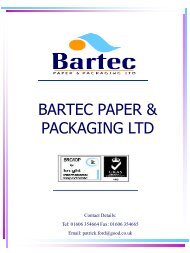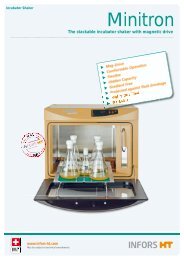Fastening & Assembly Solutions & Technology July 2012
Fastening & Assembly Solutions & Technology July 2012
Fastening & Assembly Solutions & Technology July 2012
Create successful ePaper yourself
Turn your PDF publications into a flip-book with our unique Google optimized e-Paper software.
FAST JULY <strong>2012</strong><br />
FASTUPDATES News analysis<br />
High performance<br />
composites influence the<br />
business agenda<br />
From a historical perspective, a mixed set of factors have affected the composites industry, crossing<br />
socio-political, technology, marketing and environmental issues. Philippe Michaud discusses how the<br />
market has evolved to place the development of high performance composites technologies firmly on<br />
the agenda as a key enabler across a number of market sectors<br />
Composite technologies have<br />
come a long way in a relatively<br />
short time and have made high<br />
performance composites an<br />
extremely attractive option for<br />
original equipment manufacturers<br />
(OEMs). Because they are<br />
lightweight, they bring performance<br />
advantages to numerous<br />
applications.<br />
Focused on producing high<br />
quality, complex and lightweight<br />
parts, many industries are<br />
addressing how to strike a balance<br />
between speeding up parts<br />
manufacturing, reducing investment<br />
costs and producing excellent<br />
results. Processing capabilities<br />
have thereby fallen in the<br />
spotlight with the onus on the<br />
requirement for better, high performance<br />
technologies.<br />
In the automotive sector, lowering<br />
vehicle weight is driven by<br />
the need to create overall better<br />
fuel efficiencies and enhanced<br />
power to weight ratios. Recent<br />
RTM was used to make the engine<br />
air box for Ferrari F430<br />
12<br />
years have seen high levels of<br />
activity in the global electric<br />
vehicles (EV) industry. However,<br />
electric vehicles having particularly<br />
heavy batteries, efforts are<br />
focused on how to make them as<br />
light weight as possible in order<br />
to achieve a better performance.<br />
Government directives did<br />
originally spur initiatives to<br />
reduce carbon emissions, but<br />
what we’re seeing now is both<br />
pull from the market and push<br />
from the OEMs, focused on the<br />
delivery of enhanced vehicle performance.<br />
By and large, these<br />
influencers are mostly responsible<br />
for the significant growth in<br />
the composites market today.<br />
More and more manufacturers<br />
are evaluating their carbon composites<br />
processing methods and<br />
realising the benefits of high<br />
speed resin transfer moulding<br />
(RTM) for part-a-minute production.<br />
Huntsman’s resin systems<br />
for high pressure RTM and compression<br />
moulding are already<br />
proving their ability to offer<br />
advanced processing properties<br />
and significant production time<br />
savings for direct processing,<br />
with the former enabling production<br />
cycles as short as three minutes<br />
and the latter providing even<br />
shorter cycles of less than a<br />
minute.<br />
There are differences in opinion<br />
across the automotive industry<br />
concerning just how much<br />
weight can be saved, but insight<br />
and the widespread adoption of<br />
this technology shows that when<br />
processed accurately, significant<br />
weight savings and the associated<br />
New materials enhance technical performance in the fabrication,<br />
repair and assembly of aircraft components on airliners such as the<br />
Airbus A320<br />
benefits of enhanced power-toweight<br />
ratios will follow.<br />
Aerospace advancement<br />
Moving from one market in relative<br />
infancy to another in a more<br />
advanced stage, it would be apt to<br />
say that the aerospace market has<br />
been enjoying the benefits of<br />
composites for many years. From<br />
a research point of view, the next<br />
technological challenges centre<br />
on the exploration of new processes<br />
that reduce manufacturing<br />
times and new materials to<br />
enhance the technical performance<br />
in the fabrication, repair<br />
and assembly of aircraft components<br />
on short to medium range<br />
airliners such as the Boeing 737<br />
or Airbus A320.<br />
Priorities for wind energy<br />
Wind Energy is another key market<br />
for composites and blade<br />
manufacturers are very much<br />
focused on the continuous<br />
improvement of wind turbine performance.<br />
Requirements for<br />
developing higher performance<br />
materials with an emphasis on<br />
lowering toxic risk while sustaining<br />
very good processing conditions<br />
is another key area in which<br />
Huntsman is actively concentrating<br />
its efforts.<br />
Technical and market developments<br />
over the past two decades<br />
have turned this once marginal<br />
application into a global giant,<br />
which is also fast becoming one<br />
of the world’s largest markets for<br />
composites.<br />
Wind energy is undisputedly<br />
the number one choice in<br />
Europe's efforts to move towards<br />
clean, renewable power and is<br />
expected to power industry, business<br />
and homes with clean electricity<br />
for many years to come.<br />
Philippe Michaud is Huntsman Advanced Materials technology director<br />
HUNTSMAN ADVANCED MATERIALS +41 61 299 2664











